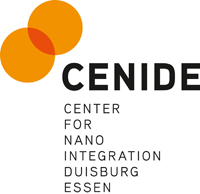Research Project 7
Optical in situ diagnostics in nanoparticle synthesis
Optical in situ diagnostic methods for reactive gas phase processes provide high potential for perturbation-free analysis of the reaction process with simultaneously high spatial and temporal resolution. Spatially resolved analysis of mixing processes, the determination of velocity fields, temperature and species concentrations, as well as the observation of particle formation can decisively contribute to a better understanding of the process. This gain in knowledge results in particular from comparisons with chemical-kinetic modeling and fluid mechanical simulations, which help to describe the reaction process and its interaction with the flow field.
The aim of this subproject is the application of Particle Imaging Velocimetry (PIV), Laser Induced Fluorescence (LIF) and Laser Induced Incandescence (LII) in the nanoparticle synthesis methods for the detailed measurement of the above mentioned quantities, and to apply these to other systems to be studied in the present project period. This requires further development of the spectroscopic basics via spectrally resolved measurements in model systems and measurements of absorption cross sections of intermediates (e.g., SiO). Conversely, the project provides support for kinetic measurements and concentration and temperature measurements in other subprojects.
The project focuses on the measurement of key species of nanoparticle synthesis and temperature by LIF imaging diagnostics in order to capture and evaluate the entity of the synthesis process. Of particular importance for the support of modeling efforts is the investigation of the spatial / temporal distribution of temperature and intermediate species (Si, SiO, SiH, Fe, FeO, ...), which mark the transition between precursor decay and particle formation. In this context particular attention should be paid to the spatial regions in the reactors where, for the production of core-shell structures or mixed crystals, an admixture of secondary precursors into the flow of particles formed initially takes place. In addition to the named methods, elastic light scattering and LII in fluence ranges up to particle-selective, laser-induced breakdown spectroscopy, LIBS, are also used. Some diagnostic methods must also be adapted for the pilot plants in the project so that experimental data for the variables of interest can also be supplied there with sufficient accuracy.
The measurements will be extended to different reactor operating conditions in order to accompany in detail the oxidative and reductive aftertreatment of particles in the mixing zones of secondary precursors. An additional focus is on the in-situ diagnostics of particle size, volume fraction and elemental composition using LII and phase-selective LIBS.
Project management
Dr. Torsten Endres
Universität Duisburg-Essen
Fakultät für Ingenieurwissenschaften
Tel.: +49 203 379-3505
E-Mail: torsten.endres@uni-due.de
https://www.uni-due.de/ivg/rf/
Prof. Dr. Christof Schulz
University of Duisburg-Essen
Faculty of Engineering
Phone: +49 203 379-8161
E-Mail: christof.schulz@uni-due.de
http://www.uni-due.de/ivg/rf/



